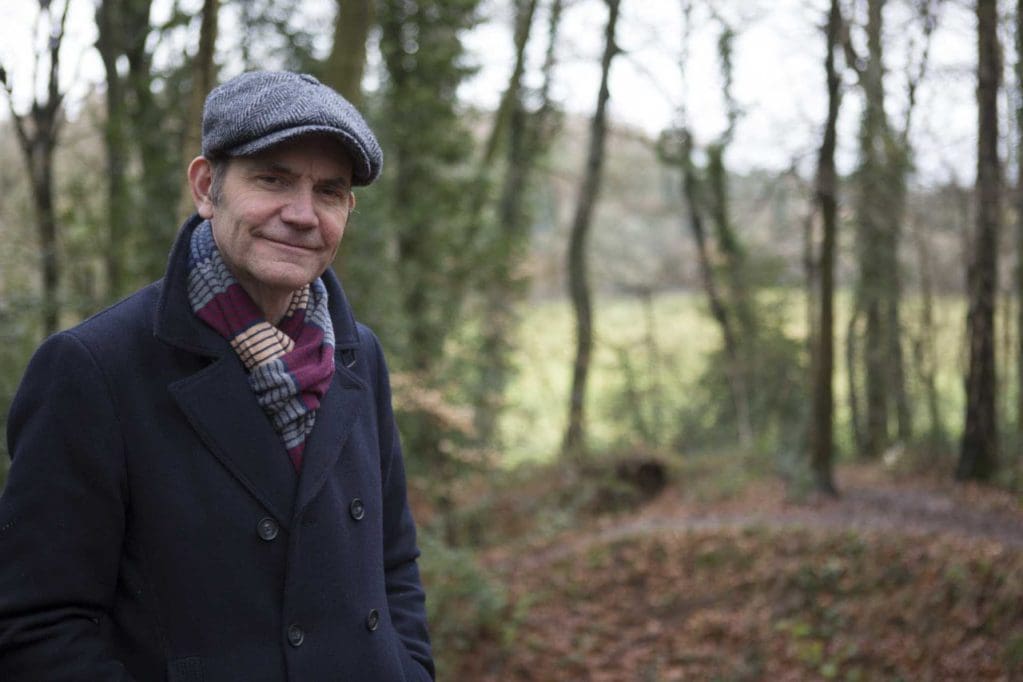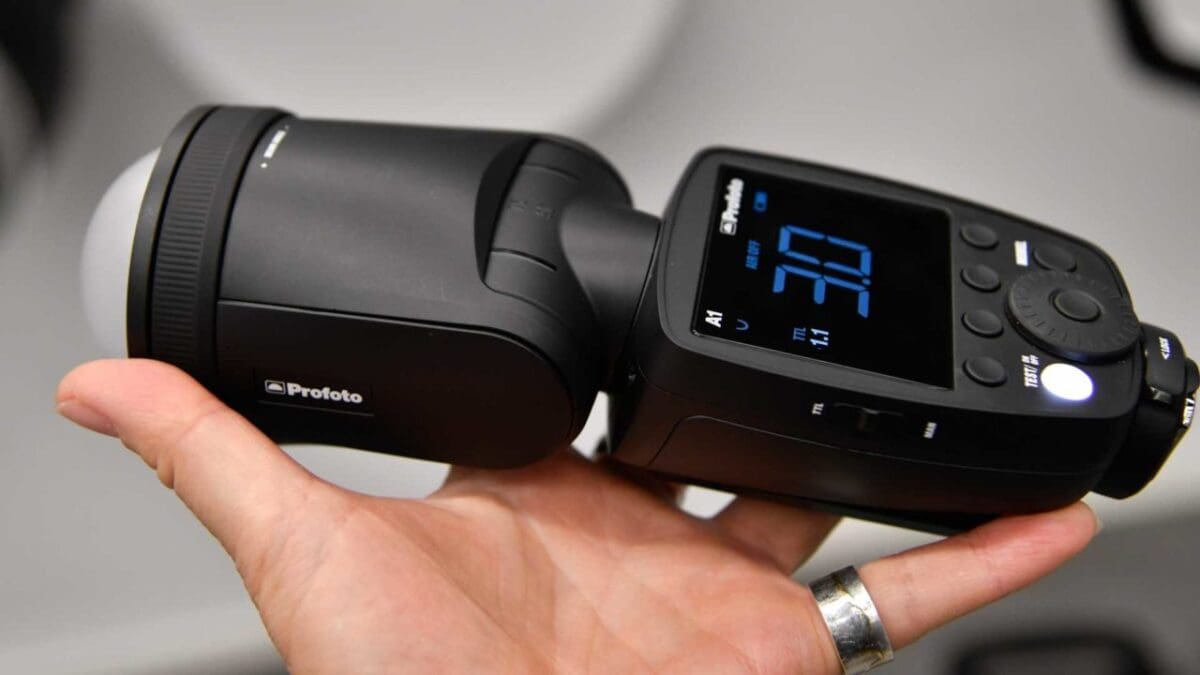Profoto A1 Snap Verdict
The Profoto A1’s main strengths are its light quality and speed of operation, despite its higher price and relatively lower power compared to other flash units. Its design facilitates natural-looking light with gradual fall-off. The A1 is durable and well-suited for high speed sync usage.
For
- More natural light than from a standard speedlight
- Air TTL built-in
- Easy to use
Against
- Expensive for the power rating
- Not weatherproof
- Screen not touch-sensitive
What is the Profoto A1?
Profoto calls the A1 the world’s smallest studio light, resembling a speedlight but with high-quality studio light features, including the Air TTL system for remote flash triggering and TTL exposure metering. It is available in Canon and Nikon mounts, with a Sony version expected.
Profoto A1 Features
The A1 has a 24.2Mp sensor and a DIGIC 7 processor, enabling a 100 – 25,600 ISO range. It features Dual Pixel CMOS AF for phase detection focusing in Live View and video mode, 4-stop Image Stabilisation, and Full-HD video capability. It has built-in Wi-Fi, NFC, and Bluetooth for easy connectivity.
The A1’s lens is a 15–45mm f/2.8-5.6 optic, providing a 24–72mm equivalent focal length range. It features a unique round lens with a Fresnel design for improved light shaping and natural catchlights.
High-speed sync (HSS) mode allows for fast shutter speeds, useful for outdoor shooting with shallow depth of field. The A1’s ceramic reflector and cooling system support extensive high-power flash usage.
A1 Battery and accessories
The A1 uses a rechargeable Li-ion battery, offering 350 full-power flashes per charge, with potential for a higher capacity battery. It comes with a magnetic mount for attaching light modifiers, and additional accessories are available.
Using the Profoto A1 with Fujifilm, Olympus, or Sony cameras
While specific Sony, Fujifilm, and Olympus versions are pending, Canon or Nikon A1 units can be used off-camera with the appropriate Profoto Air Remote TTL, supporting TTL mode across different camera brands.
Profoto A1 Specification
The Profoto A1 features a guide number of around 40, Dual Pixel CMOS AF, 4-stop Image Stabilisation, and comes with a range of accessories for versatile lighting setups.
Profoto A1 Build Quality and Handling
The Profoto A1, while resembling a high-end flashgun, stands out for its user-friendly interface and round head designed for natural light quality. It features manual and TTL mode switches, an accessible control layout with a central dial for adjustments, and an LCD screen that clearly shows key settings. Adjusting power and flash exposure compensation is straightforward, enhancing the ease of use during shoots.
Controlling Output
The A1’s display shows flash power and, in TTL mode, flash exposure compensation, which is easily adjusted via the control dial. This quick access to exposure compensation facilitates balancing ambient light and flash illumination effectively.
The Interface
The A1 simplifies the use of multiple flash units with its Air feature, allowing for easy grouping and channel selection for coordinated control. Although not touch-sensitive, the interface is intuitive, with the potential for future models to include this feature. Firmware updates have improved the control dial’s functionality, preventing accidental adjustments.
Profoto A1 Accessories
The A1’s magnetic mount allows for effortless attachment of light modifiers. The included wide-angle diffuser and dome diffuser enhance lighting versatility, with a soft case providing convenient storage. The optional soft-bounce accessory, while larger, integrates seamlessly with the A1, although it can make the setup feel top-heavy when attached to a camera.
Profoto A1 Performance
There are lots of variables when using flash, the distance to the subject, the distance between the subject and the background and the angle of the flash or the use of a supplied modifier will all have an impact. The ease of use of the A1 encourages you to experiment and get creative to take more interesting images.
When shooting with a Canon 5D Mark III with the A1 set to TTL mode, I often found that I needed to reduce its output. In some cases it was only a case of 1/3 or 2/3EV, but in others it was more a significant figure. This is easy to do via the large dial on the back of the camera.
If you want to take manual control over the A1 it’s worth taking a couple of shots in TTL mode first. Then when you switch to Manual, the TTL power output mode will automatically be set and you can make adjustments from there to get the result you want.
Air TTL
At the launch event when there was a large group of photographers shooting together there was the occasional blip with the Air connection. However, it’s possible (probably) that another photographer with the same settings as me had pressed their camera’s shutter release a fraction of a second before me so I had an exposure error. It’s not an issue I encountered when shooting on my own and I’m pressed with how quick and easy the Air TTL system is to use.
Unlike some remote systems, it doesn’t require any head-scratching or reconnections to be made, it just works and it makes shooting with and controlling multiple flash units easy.
Image Quality
Using the A1 directly produces images that are better than I’d expect from direct flash and attaching the dome diffuser softened things down nicely, creating an attractively natural looking result.
I found that my subject’s skin generally looks nicer and less shiny with the unmodified A1 than with some flashguns.
However, I spent some time comparing results and I couldn’t see a difference in the catchlight shape when using an unmodified Canon 600EX-RT, they look round.
The fall-off in brightness towards the corners of the frame also seems more dramatic with the A1 than with the Canon flashgun, but it’s quite attractive.
The images below demonstrate the impact of using the A1 outdoors as a fill light. Even though it was an overcast day, without flash there are shadows on the subject’s face. Using the A1 on-camera with the supplied Dome diffuser has filled-in those shadows to make a more flattering result. There’s a shadow from the peak of the cap, but it’s not too distracting.



The images below are straight from the camera, showcasing the capabilities of the Profoto A1 when used with either the Canon 6D Mark II or the Nikon D850:
- Sample image taken with Profoto A1, displaying its ability to produce well-exposed and detailed photographs.
- Another example of the Profoto A1’s performance, highlighting its effectiveness in creating natural-looking light and shadow.
- A photograph demonstrating the Profoto A1’s capacity to handle complex lighting situations, maintaining detail and color accuracy.
- An image showing the Profoto A1’s proficiency in producing high-quality, professional-looking shots in various conditions.
To view and download more sample images shot using the Profoto A1, you can visit the provided Flickr link.
Profoto A1 Verdict
Profoto has taken a fresh approach to designing the A1, focusing on natural light production, ease of use, and effective light shaping. The result is a flash unit that addresses common concerns with speedlights, offering more natural-looking light, user-friendly magnetic modifiers, and a robust Li-ion battery system for quick recycling times. While not the most powerful flash on the market and priced at a premium, the A1’s build quality and included modifiers make it a valuable tool for photographers, despite the lack of a touch-screen interface and the extra cost of purchasing a spare battery.
Should I buy the Profoto A1?
The Profoto A1 is ideal for wedding and portrait photographers seeking portable, easy-to-use lighting. Its intuitive controls and efficient battery system make it suitable for on-the-go shooting, although it may not replace powerful studio lights in very bright conditions. For those in less intense sunlight or overcast settings, the A1 offers the necessary output for high-quality portraits. While new users might need to familiarize themselves with multi-flash setups, the A1’s straightforward operation allows for quick learning and effective use.



